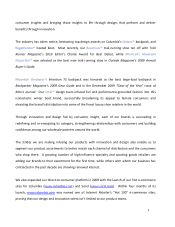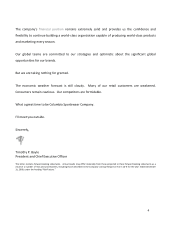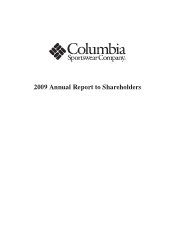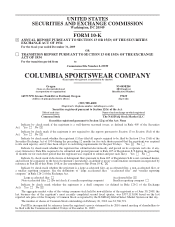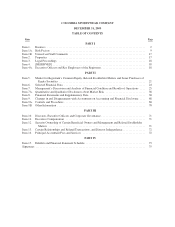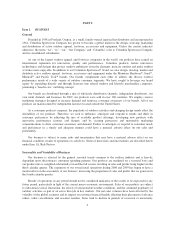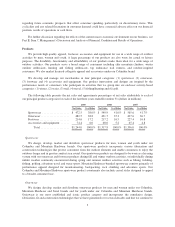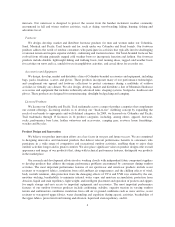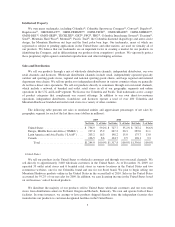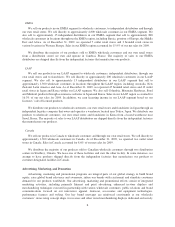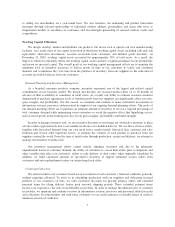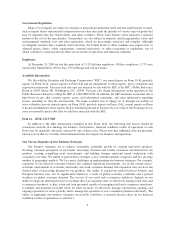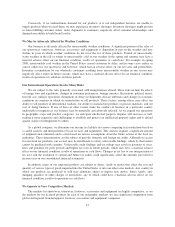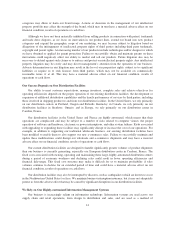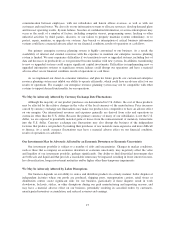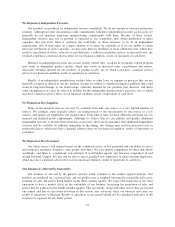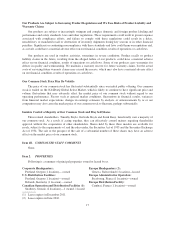Columbia Sportswear 2009 Annual Report Download - page 14
Download and view the complete annual report
Please find page 14 of the 2009 Columbia Sportswear annual report below. You can navigate through the pages in the report by either clicking on the pages listed below, or by using the keyword search tool below to find specific information within the annual report.to selling our merchandise on a year-round basis. We also reinforce our marketing and product innovation
messages through selected sponsorships of individual outdoor athletes, personalities and teams who serve as
inspirational models of excellence to consumers and also through sponsorship of selected outdoor events and
competitions.
Working Capital Utilization
We design, develop, market and distribute our products, but do not own or operate our own manufacturing
facilities. As a result, most of our capital is invested in short-term working capital assets, including cash and cash
equivalents, short-term investments, accounts receivable from customers, and finished goods inventory. At
December 31, 2009, working capital assets accounted for approximately 76% of total assets. As a result, the
degree to which we efficiently utilize our working capital assets can have a significant impact on our profitability
and return on invested capital. The overall goals of our working capital management efforts are to maintain the
minimum level of inventory necessary to deliver goods on time to our customers to satisfy end consumer
demand, and to minimize the cycle time from the purchase of inventory from our suppliers to the collection of
accounts receivable balances from our customers.
Demand Planning and Inventory Management
As a branded consumer products company, inventory represents one of the largest and riskiest capital
commitments in our business model. We design and develop our seasonal product lines 12 to 18 months in
advance of their availability to consumers in retail stores. As a result, our ability to estimate seasonal consumer
demand and to purchase appropriate levels of finished goods from our suppliers can significantly affect our sales,
gross margins and profitability. For this reason, we maintain and continue to make substantial investments in
information systems, processes and personnel in support of our ongoing demand planning efforts. The goals of
our demand planning efforts are to purchase an adequate amount of inventory to service a targeted percentage of
total consumer demand while minimizing excess inventory to avoid the negative effect that liquidating excess,
end-of-season goods at discounted prices has on our gross margins, profitability and brand strength.
In order to manage inventory risk, we use incentive discounts to encourage our wholesale customers to place
advance orders approximately four to six months in advance of scheduled delivery. We use those advance orders,
together with forecasted demand from our own retail stores, market trends, historical data, customer and sales
feedback and several other important factors, to estimate the volumes of each product to purchase from our
suppliers around the world. From the time of initial order through production, receipt and delivery, we attempt to
manage our inventory to reduce risk.
Our inventory management efforts cannot entirely eliminate inventory risk due to the inherently
unpredictable nature of consumer demand, the ability of customers to cancel their orders prior to shipment, and
other variables that affect our customers’ ability to take delivery of their orders when originally scheduled. In
addition, we build calculated amounts of speculative inventory to support estimated at-once orders from
customers and auto-replenishment orders on certain long-lived styles.
Credit and Collection
We extend credit to our customers based on an assessment of each customer’s financial condition, generally
without requiring collateral. To assist us in scheduling production with our suppliers and delivering seasonal
products to our customers on time, we offer customers discounts for placing advance orders and extended
payment terms for taking delivery before peak seasonal shipping periods. These extended payment terms
increase our exposure to the risk of uncollectible receivables. In order to manage the inherent risks of customer
receivables, we maintain and continue to invest in information systems, processes and personnel skilled in credit
and collections. In some markets and with some customers we use credit insurance or standby letters of credit to
minimize our risk of credit loss.
7


